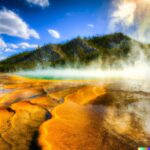Have you ever marveled at the power and beauty of a geyser erupting? Grand Geyser in Yellowstone National Park is a true wonder of nature, known for its impressive eruptions and stunning display. In this article, we will explore the history, characteristics, and significance of Grand Geyser, as well as how you can witness its eruptions firsthand. Join us on a journey to discover the magic of this incredible natural phenomenon and the other geysers that surround it.
What Is Grand Geyser?
Grand Geyser, located in Yellowstone National Park, is a mesmerizing geothermal feature known for its majestic eruptions and stunning geyser basin.
Visitors flock to witness the grandeur of Grand Geyser, the tallest predictable geyser in the world. This natural wonder showcases rare thermal activity, with its eruptions reaching heights of up to 200 feet. The rhythmic bursts of boiling water against the backdrop of the park’s diverse landscape create a spectacle that mesmerizes all who are fortunate enough to experience it.
The unpredictable nature of geysers adds an element of suspense and excitement to the viewing, making each eruption a thrilling event that showcases the raw power of nature.
What Is a Geyser?
Geysers are hydrothermal features characterized by intermittent eruptions of hot water and steam, fueled by underground geothermal activity and varying eruption intervals.
These unique geological formations typically occur in regions with high geothermal activity, such as volcanic areas or tectonic plate boundaries. The formation of geysers begins with groundwater seeping deep into the Earth’s crust where it comes into contact with hot rocks, causing the water to heat up and rise back towards the surface. As the water gets hotter, pressure builds up underground until it eventually forces its way out through narrow openings, resulting in the spectacular steam eruptions that are synonymous with geysers.
The significance of hot water in geyser eruptions lies in its ability to generate steam, which then propels the water upwards in a powerful display of nature’s forces.
Where Is Grand Geyser Located?
Grand Geyser is situated in the Upper Geyser Basin of Yellowstone National Park, making it a must-visit tourist destination renowned for its scenic views and natural wonders.
Nestled amidst the vibrant geothermal features that Yellowstone is famous for, Grand Geyser captivates visitors with its towering eruptions that can reach heights of up to 200 feet, creating a mesmerizing spectacle against the backdrop of the rugged Rocky Mountains.
The area surrounding Grand Geyser is a photographer’s paradise, offering numerous vantage points for capturing the steaming geysers and colorful mineral pools that dot the landscape. The bubbling hot springs, hissing fumaroles, and bubbling mud pots add to the unique charm of this geothermal wonderland.
What Is the History of Grand Geyser?
The history of Grand Geyser is steeped in the geological formations of Yellowstone National Park, showcasing its volcanic origins and intricate geological history.
Yellowstone National Park, renowned for its geothermal features, is situated upon a supervolcano that fuels its diverse array of geysers and hot springs. The park’s formation dates back millions of years, with volcanic activity shaping the landscape over time. Grand Geyser, one of the park’s most famous geysers, stands as a testament to this dynamic geological past, erupting in a spectacular fashion due to the underground pressures and hydrothermal systems that exist beneath the Earth’s surface in this region. The ongoing volcanic processes within Yellowstone contribute to the continuous evolution and preservation of Grand Geyser and the park’s other geothermal wonders.
Who Discovered Grand Geyser?
Grand Geyser was discovered during early geothermal explorations in Yellowstone National Park, marking a significant find in the realm of scientific research and geothermal exploration.
At the time of its discovery, Grand Geyser sparked great interest among geologists and researchers due to its unique behavior and impressive eruptions. The exploratory efforts that led to its identification involved meticulous observation of the geothermal features in the area, coupled with a keen understanding of the geological processes at play. Scientists conducting fieldwork in Yellowstone National Park played a crucial role in unraveling the mysteries of Grand Geyser, contributing valuable insights to the broader scientific community studying geothermal phenomena.
When Was Grand Geyser First Documented?
Grand Geyser was first documented in historical records, providing valuable insights for geological interpretations and enriching the natural history of the park.
The historical documentation of Grand Geyser showcases its importance in understanding the geological processes at work in Yellowstone National Park. By examining these records, researchers can piece together the geyser’s behavior over time and gain a deeper understanding of the park’s hydrothermal features. This information not only sheds light on the geyser itself but also contributes to broader studies on geothermal activity and volcanic landscapes. Through this documentation, Grand Geyser serves as a significant marker in the park’s natural history, highlighting the dynamic and ever-changing nature of its geology.
What Is the Significance of Grand Geyser?
Grand Geyser holds immense significance due to its ecological importance, provision of ecosystem services, and potential for geothermal energy exploration.
The geothermal activity at Grand Geyser contributes to the unique thermal features that support a variety of microorganisms and plant life. These ecosystems thrive in the extreme conditions created by the geyser’s hot water and mineral-rich environment. Not only does Grand Geyser provide habitat for specialized species, but it also serves as a natural filtration system, purifying water as it flows through the hot springs. This purification process is vital for maintaining water quality and supporting the overall health of the surrounding ecosystem.
What Are the Characteristics of Grand Geyser?
Grand Geyser showcases distinctive characteristics, including a predictable eruption pattern, varying water temperatures, and mesmerizing mineral deposits around its vent.
Its eruption pattern is fascinating, with eruptions reaching heights of up to 200 feet, making it one of the tallest geysers in the world. The intervals between eruptions can vary from 8 to 15 hours, adding to the anticipation and excitement for visitors. The fluctuating water temperatures are due to the mixing of hot water from the geyser’s underground reservoir with cooler surface water. This blending creates a dynamic display of steam and bubbling water. The mineral deposits left behind by Grand Geyser’s eruptions form intricate patterns of colorful terraces, adding to the mystical beauty of the surrounding landscape.
What Is the Eruption Pattern of Grand Geyser?
Grand Geyser follows a specific eruption pattern characterized by regular eruption intervals, varying eruption durations, and occasional interactions with nearby geysers like Steamboat Geyser.
One of the notable features of Grand Geyser is its predictable eruption timing, typically occurring every 7 to 15 hours. During an eruption, Grand Geyser releases a towering column of water and steam that can reach heights of 150 to 200 feet, captivating spectators with its majestic display. The eruptions usually last for about 9 to 12 minutes, making it a significant event in the Upper Geyser Basin. Its interactions with Steamboat Geyser, the world’s tallest active geyser, are of particular interest to geologists studying geothermal activity in Yellowstone National Park.
How High Does Grand Geyser Erupt?
Grand Geyser erupts to impressive heights, showcasing the dynamic forces of volcanic activity and the captivating geothermal phenomena that define its eruptions.
During its eruptions, Grand Geyser can spout water up to an astonishing height of over 200 feet, propelled by the intense pressure exerted by the superheated water and steam beneath the Earth’s surface. The interaction between molten rock, water, and steam creates a volatile mix that erupts with dramatic flair. This eruption height is a testament to the immense energy stored within the geyser’s underground reservoirs, unleashed in a mesmerizing display of nature’s power and beauty.
What Is the Temperature of Grand Geyser?
The temperature of Grand Geyser’s eruptions is influenced by its hot springs origin, sustained by an underground heat source that fuels the geyser’s thermal activity.
This interplay of geological factors results in the water temperature of Grand Geyser’s eruptions reaching scorching levels. The hot springs serve as natural conduits for the underground heat to channel upwards, heating the water trapped in the geyser’s chambers. As the pressure builds and the water temperature rises, the geyser eventually releases its contents in a powerful burst of steam and boiling water, showcasing the immense energy harnessed from beneath the Earth’s surface. This fascinating connection between hot springs and underground heat sources provides a captivating insight into the complex workings of geothermal features like Grand Geyser.
What Is the Composition of Grand Geyser’s Water?
Grand Geyser’s water composition features distinct mineral deposits, reflecting the geyser’s interaction with hydrothermal features and the unique geological formations of the region.
These mineral deposits, including silica, sulfur, and calcium carbonate, contribute to the mesmerizing colors seen in the water as it erupts into the air. The connection between the geyser’s water and the surrounding hydrothermal features is a testament to the intricate network of underground systems influenced by the region’s geological formations. The heat from the Earth’s core, facilitated by these geological formations, plays a vital role in creating the ideal conditions for the geyser’s spectacular displays, showcasing nature’s fascinating interplay of elements.
How Can You See Grand Geyser Erupt?
Witnessing the breathtaking eruptions of Grand Geyser is possible through guided tours, accessible hiking trails, and informative visits to the nearby visitor center.
As visitors stand in awe of the powerful eruptions of Grand Geyser, they can also take advantage of the tourist-friendly amenities that make the experience both enjoyable and educational. The geyser’s eruption schedule, provided by park rangers, ensures that visitors have the best chance of witnessing this natural wonder in action.
After marveling at the geyser’s display, adventurers can explore the surrounding hiking trails, immersing themselves in the park’s stunning landscapes and diverse flora and fauna. For a comprehensive understanding of the geothermal features in the area, a visit to the visitor center is highly recommended, offering interactive exhibits and knowledgeable staff to enhance the overall experience.
What Other Geysers Are Near Grand Geyser?
Grand Geyser shares proximity with iconic geysers like Old Faithful, forming a harmonious relationship within the geothermal landscape of Yellowstone National Park.
- These neighboring geysers, including Old Faithful, showcase a dynamic interplay that stems from their interconnected geothermal systems. The presence of multiple geysers in close vicinity underscores the intricate balance of geothermal activity in this region.
Old Faithful, known for its regular eruptions, stands as a testament to the natural wonders of Yellowstone. It serves as a reminder of the importance of understanding geothermal safety measures when exploring these geothermal features. Visitors are encouraged to adhere to designated paths and guidelines to ensure both their safety and the preservation of the geysers’ fragile ecosystems.
What Is the Relationship Between Grand Geyser and Old Faithful?
The relationship between Grand Geyser and Old Faithful extends beyond their shared geothermal features, offering valuable insights for geological interpretations and understanding the dynamic nature of geysers.
Grand Geyser, known for its towering eruptions, and Old Faithful, famous for its regular and predictable displays, both demonstrate the power and unpredictability of geothermal activity. These geysers showcase unique characteristics such as intricate plumbing systems and thermal reservoirs beneath the Earth’s surface, providing researchers with clues about the underlying geological structures. By studying their behaviors and interactions, scientists can gain a deeper understanding of subsurface processes and how geological features shape the landscapes we see today.
Last Updated on February 8, 2024 by Jon Waraas – Originally Posted: February 8, 2024

I’m Jon Waraas, and I’ve been navigating the online world since 2006. By day, I’m the proud owner of some eCommerce gems, and by night, I’m the voice behind the adventures on Waraas.Com.
My heart, however, belongs to the wild beauty of Yellowstone National Park. I’ve got a collection of websites dedicated to sharing the wonders of this natural masterpiece. Oh, and did I mention? I’m currently building my own cabin inside the ghost town of Gilmore, Idaho – a cabin with tales to tell!
When I’m not immersed in the digital realm, you’ll find me lacing up my boots for a good hike or setting up camp under the star-studded sky.




